
How Often Should You Work Out Per Week to Build Muscle?
If you want to build muscle quickly, you need to work out often enough to keep your muscles growing all week long. There are two key questions we need to answer:
- How often should you train your muscles?
- How many days per week should you work out?
If you do a full-body workout 3 times per week, you train each muscle 3 times per week. However, if you use a 6-day workout split, dividing your body up into 6 different areas, you may only be training each muscle once per week. That means it’s possible to work out more often while training your muscles less often, or vice versa.
First, we need to determine how often you should train each muscle. Then we can talk about the best way to schedule your workout routine so that you’re working each muscle hard enough, often enough.
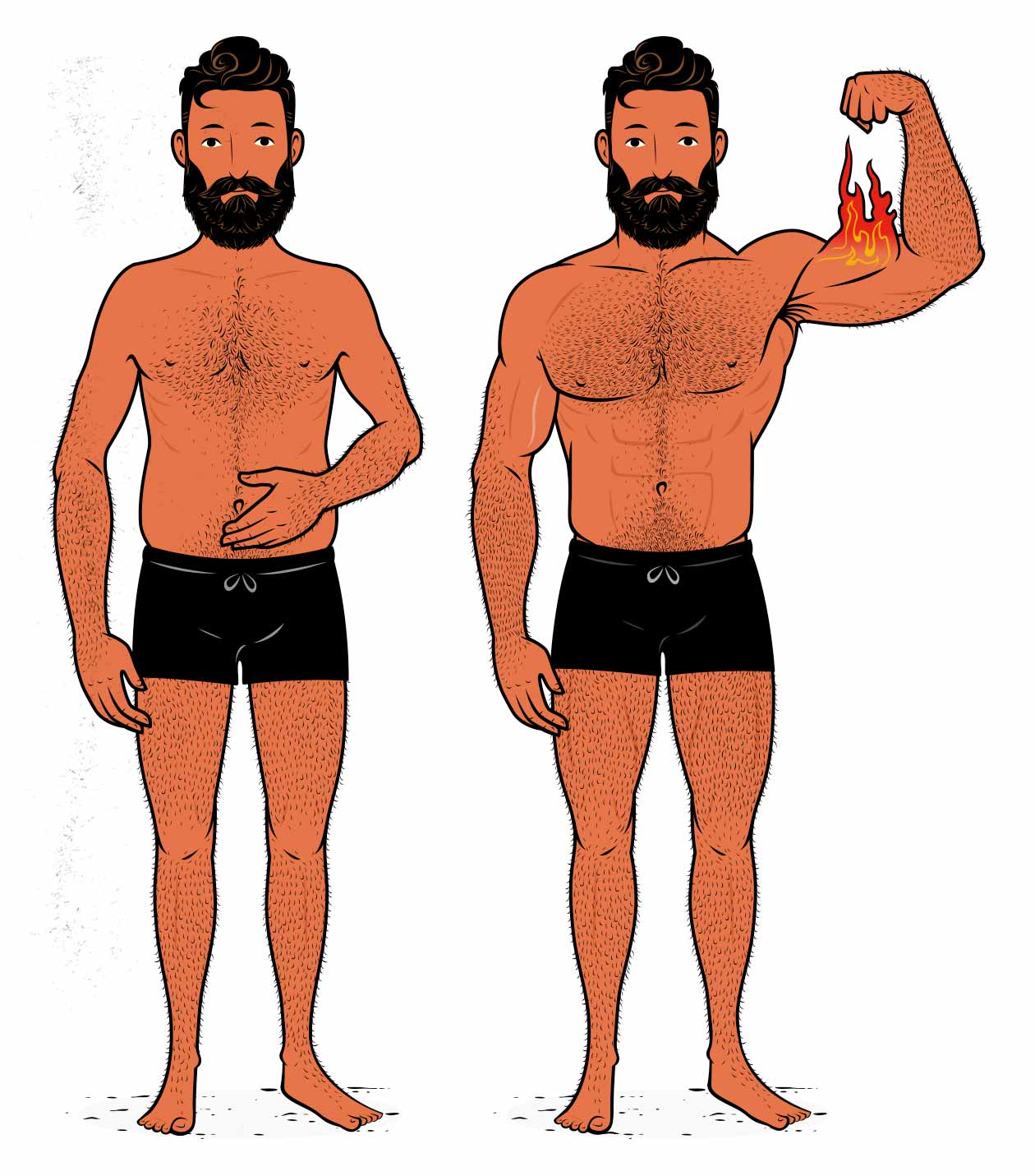
How Often Should You Train Your Muscles?
How Long Do You Build Muscle After Lifting Weights?
If you want to build muscle as fast as possible, you should keep your muscles growing steadily all week long. That means you should stimulate muscle growth, let the muscle recover and grow, and then stimulate a new wave of muscle growth.
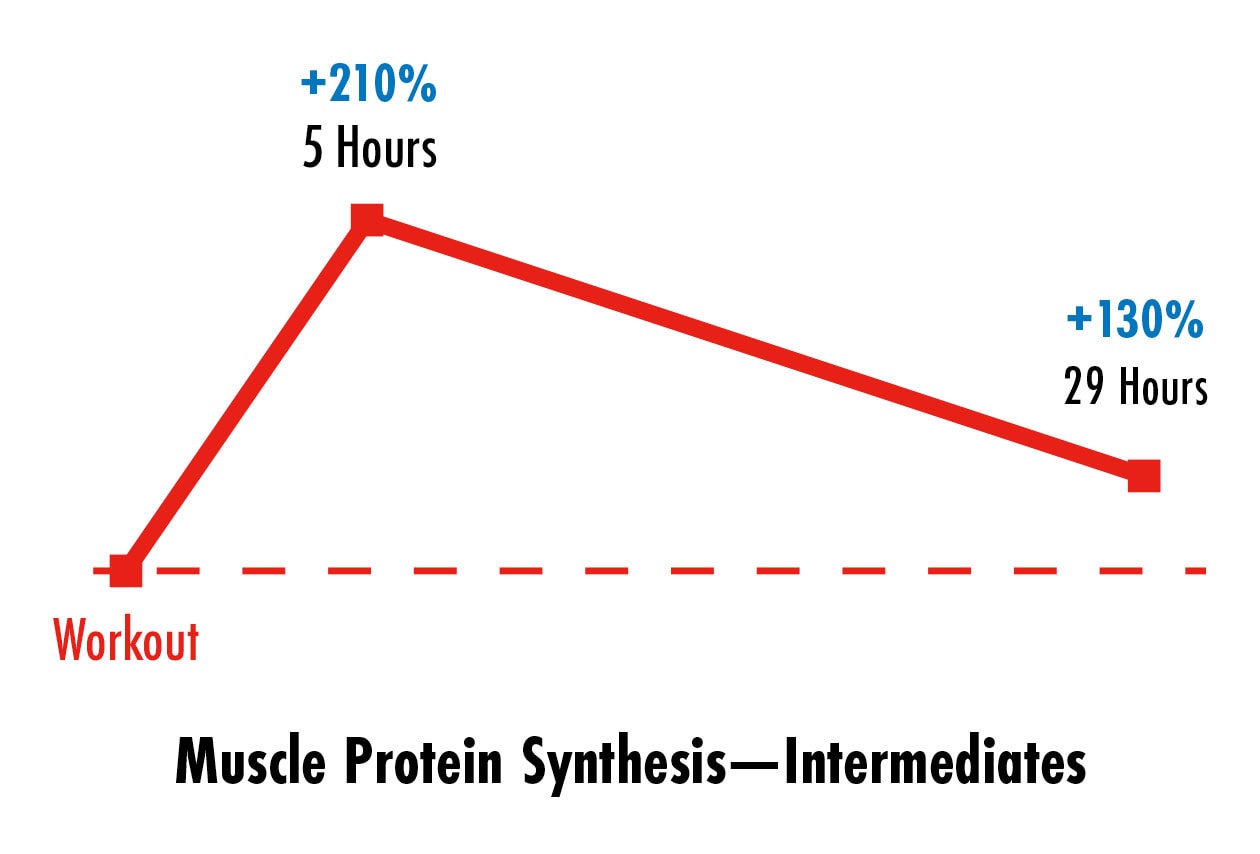
In a study done on intermediate lifters, doing a single exercise for 3 sets stimulated at least a day of muscle growth (study). In a second study, doing an exercise for 6 sets stimulated at least 2 days of muscle growth (study). In a third study, a rigorous workout stimulated 3 days of muscle growth (study). This pattern holds true for both beginner and intermediate lifters (systematic review).
Overall, the research shows that we can recover quickly from easy workouts, allowing us to train almost every day. On the other hand, if our workouts are harder, a single workout can stimulate several days of muscle growth, allowing us to maximize our rate of muscle growth with as few as 2–3 workouts per week.
Note: just to clear up any potential confusion, we’re talking specifically about muscle growth, so we’re talking specifically about myofibrillar protein synthesis—building muscle fibres.
That can get confusing because some research, such as this study, shows that mixed muscle-protein synthesis abates after about 24 hours in intermediate lifters. Studies like that are often used to show that our workouts only stimulate a single day of growth.
Recovery & The Repeated Bout Effect
We also need to consider how long it takes to recover from our workouts, and that doesn’t always line up with muscle growth. Maybe a workout stimulates 2–3 days of muscle growth, but it takes us 4–5 days for the soreness to abate and our performance to return.
People who aren’t in the habit of lifting weights are especially vulnerable and can get sore for a full week after lifting weights. Even with habitual lifters, starting a new training routine can cause quite a lot of muscle damage.
That’s where the repeated bout effect comes in. Over time, as we acclimatize to a workout program, we grow tougher, our workouts cause less muscle damage, and we start being able to recover much more quickly, allowing us to train more often.
For example, in this study, it took people four days to recover from their first workout but only a single day to recover from their second workout.
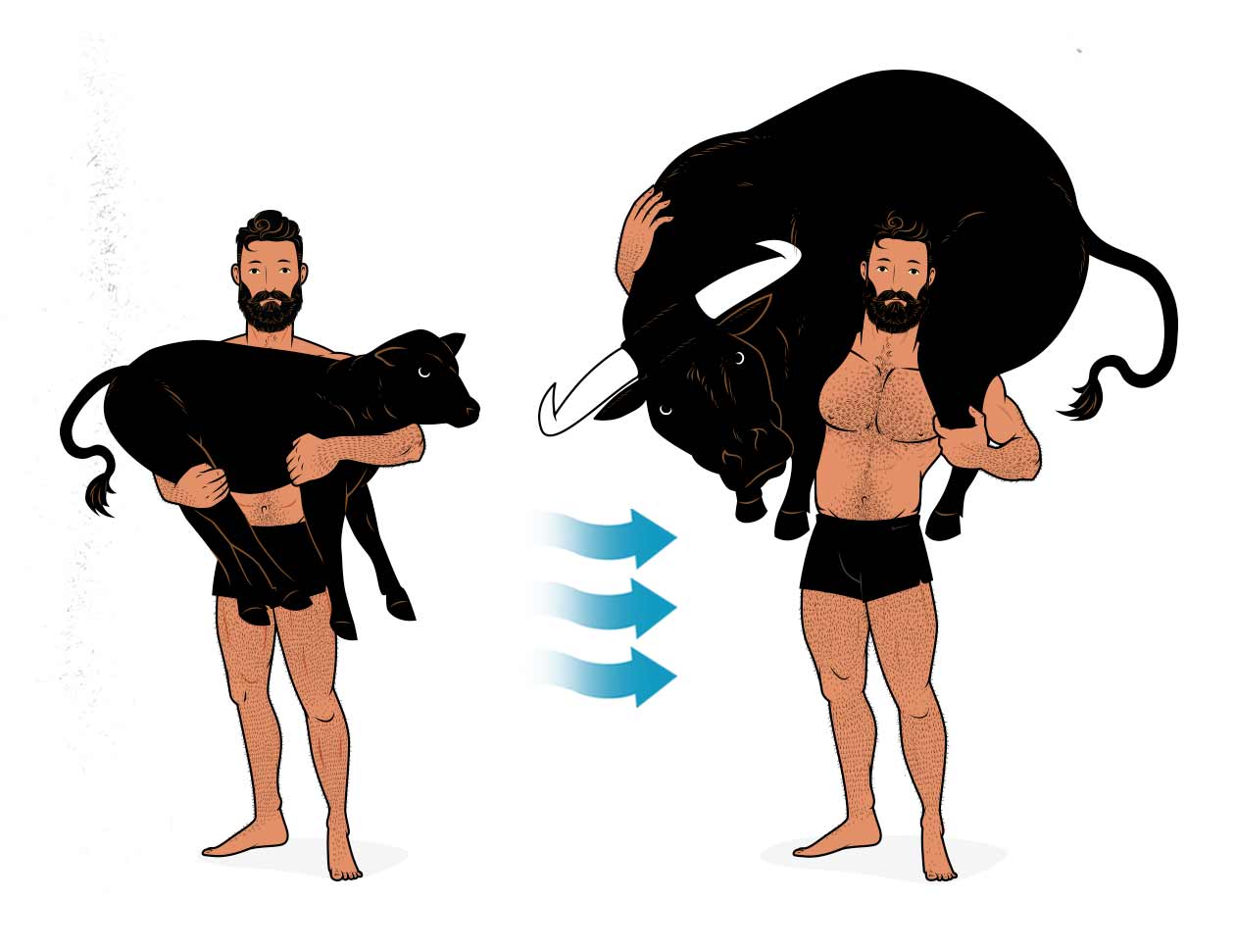
For another example, in this study, doing 3 sets per exercise caused 3 days of muscle damage, preventing the participants from outlifting themselves 2 days later. In this case, it would have been better to start with 2 sets per exercise or wait 3 days between workouts.
Training Your Muscles Once Per Week
Okay, so we know that working out stimulates muscle growth for 2–3 days, but that doesn’t necessarily tell us how often we should be working out. To know for sure, we should look at how much actual, bonafide muscle growth people get from different training frequencies.
A recent study by Schoenfeld did just that. He had one group training their muscles once per week using a push/pull/legs split, and the other half training their muscles 3 times per week using full-body workouts. Both groups did 3 workouts per week, and both did the same number of exercises and sets, giving them the same overall training volume. The only difference was how often they were training their muscles.
All of the muscles we investigated showed greater growth from a higher training frequency.
Brad Schoenfeld, PhD
The group doing full-body workouts saw greater muscle growth in every area that reached statistical significance (such as biceps growth). In fact, even in the metrics that didn’t reach statistical significance, such as strength gains and overall muscle growth, the full-body group still did better.
Training your muscles once per week is enough to stimulate muscle growth, but we can build muscle even faster by training our muscles at least twice per week.
Training Your Muscles 2–4 Times Per Week
After the Schoenfeld study, a new wave of research crashed in. All of the studies came to the same conclusion: doing just a few sets per muscle group is enough to stimulate muscle growth, but we should be training our muscles every 2–4 days (meta-analysis).
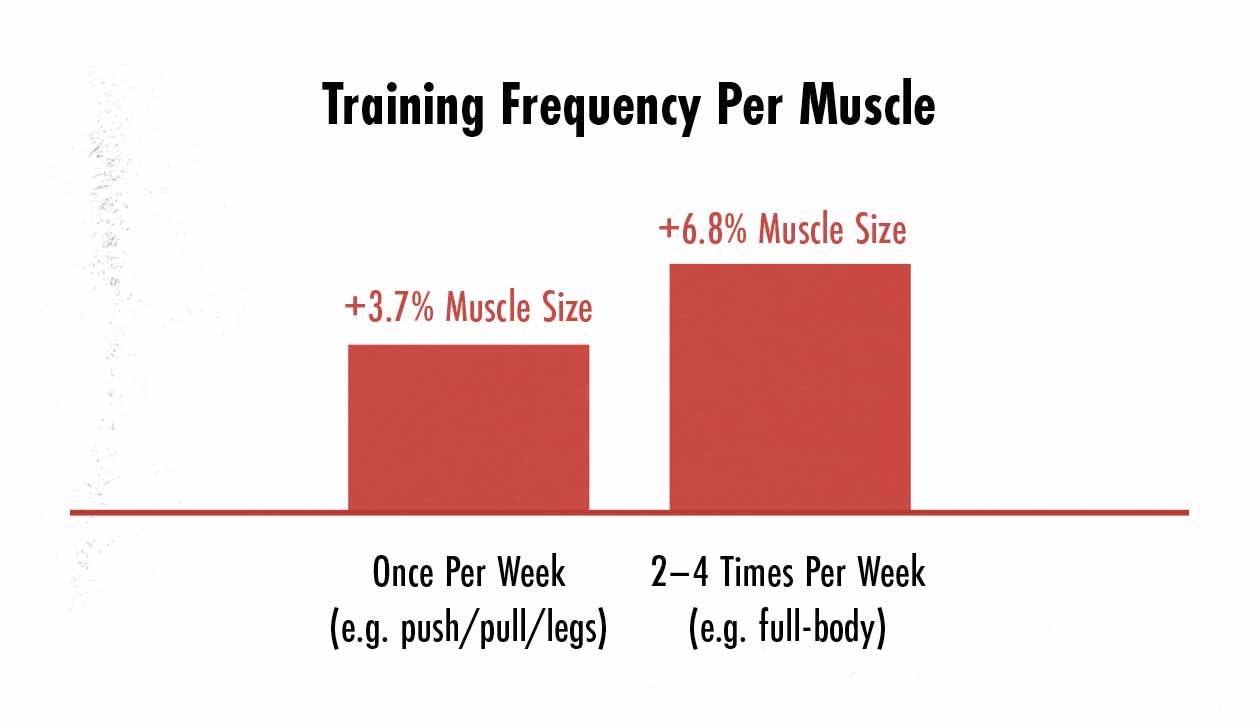
In fact, every single study found a benefit to training our muscles at least 2–4 times per week. The effect was quite large, too, showing 48% faster muscle growth.
This extra muscle growth can be explained by two things:
- Frequency: if we train our muscles every 2–4 days, we can keep our muscles growing all week long, building muscle faster.
- Pacing: if we spread each muscle’s work over multiple workouts, fatigue is less of an issue, allowing us to lift more weight and eke out more reps, stimulating more muscle growth.
Training our muscles once per week isn’t enough to maximize our rate of muscle growth. If we train our muscles 2–4 times per week instead, we can build muscle around 48% faster.
Training Your Muscles Every Day
So, we know that workout out our muscles 2–4 times per week builds more muscle than working them out just once per week. Great. But what about if we train our muscles every day? Would that help us build muscle even faster?
That’s where high-frequency training comes in. High-frequency training is based on the idea that you can build muscle even faster by training your muscles 4–6 times per week. That means doing shorter, easier workouts. Instead of doing 3–8 sets per muscle group per workout, you might only do 1–3 sets. And instead of lifting close to failure, you might stop a good few reps shy. That way you aren’t causing as much muscle damage each workout, allowing you to work out more often.
Even so, there are some things to watch out for. Just because our target muscles are recovering, that doesn’t mean our tendons and joints are. And what about the muscle we use every workout, like those in our hands, forearms, upper traps, and spine? That’s why hypertrophy researcher James Krieger, MS, notes that high-frequency training can cause wear and tear on our joints. That’s why he had to stop his experiment of working out every day, reverting back to a more conventional approach. He also noted that working out every day wasn’t giving him faster muscle growth or strength gains. The only noticeable difference was more joint pain.
Plus, there doesn’t seem to be a benefit to training your muscles every day. If you work your muscles hard enough, you can stimulate 2–4 days of muscle growth with a single workout, so there’s little benefit to training more often than that. It could be that some people benefit from working out more frequently, and some people certainly prefer it, but for the majority of people, it doesn’t seem to help. We’re already gaining muscle at full speed.
To be fair, there’s some research showing that high-frequency training can help us build muscle faster. But that research compares training our muscles every day against training them just once per week. If we look at studies like this one, and this one, we see that training our muscles 3 times per week is just as good as training them 6 times per week. Both groups gained the same amount of muscle mass and strength. The same is true when we compare 5-day full-body routines against 5-day split routines. Both produce the same amount of muscle growth (study).
High-frequency training is a new style of training without much research looking into it. At the moment, there’s no evidence that training a muscle every day causes more muscle growth than training it twice per week.
How Often Should You Train Different Muscles?
We’ve covered why training our muscles 2–4 times per week is ideal for building muscle. But that’s a range. Should you stimulate your muscles 2, 3, or 4 times per week? It depends on a few different factors, and one of those factors is which muscle group we’re talking about.
Beginners are sensitive to muscle damage, so it helps to ease in slowly, starting with just a couple of sets per exercise. However, they’re also able to train quite frequently, given that their muscles aren’t very big yet, and they aren’t strong enough to cause much disruption. At this point, training your muscles 3 times per week is ideal, and full-body workout routines are a great way to do that.
As you build more muscle, you’ll learn to push yourself, your bigger muscles will work harder, and your tendons and bones will be under more pressure. At that point, it’s harder to stimulate growth, the workouts become more tiring, and extra recovery days become more valuable. This is where workout splits can come in.
As a general rule of thumb, you should do enough reps to get a pump, do enough sets to fatigue your muscles, and work your muscles hard enough to cause at least some soreness. Then, when that soreness abates, you’re ready to train those muscles again.
How Often Should You Train Your Chest?
Your chest is one of your bigger and stronger muscle groups, and it’s possible to train your chest quite hard, stimulating a ton of muscle growth and also causing quite a lot of muscle damage. Once you’re good at the bench press, training your chest twice per week is often enough.
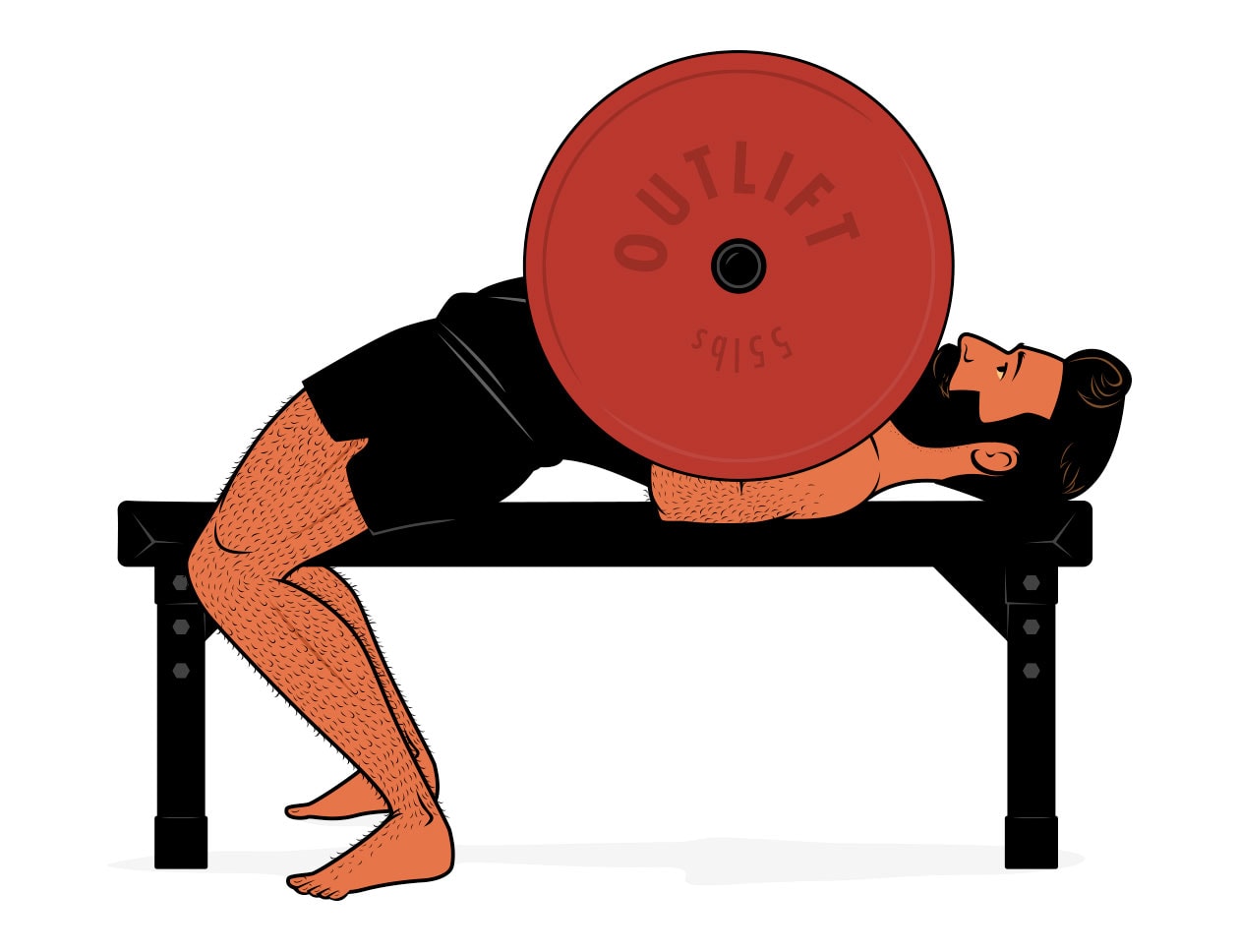
If we look at the bench press, it’s a lift that challenges your chest in a deep stretch, stimulating a ton of muscle growth and also causing quite a lot of disruption. For example, this study found that it took 4 days to fully recover from doing 8 sets of the bench press.
To be fair, 8 sets of bench presses are quite a lot, and in this study, where the participants did just 3 sets of 10 repetitions on the bench press, it only took 2–3 days for their chests to recover. So if you do fewer sets, you can train your chest more often. And if you do more sets, you might need longer to recover. Both approaches seem to produce a comparable amount of muscle growth. It’s up to you.
To stimulate a maximal amount of muscle growth, focus on lifts that challenge your chest in a deep stretch, such as dips, the barbell bench press, dumbbell bench press, close-grip bench press, deficit push-up, and dumbbell fly. Doing 6–20 reps per set will stimulate the most muscle growth, and doing 3–8 sets per workout tends to be ideal.
How Often Should You Train Your Back?
Most people can get away with working out their backs quite frequently, training it 3–4 times per week without running into any issues. And that’s good because our backs are involved in almost every lift we do!
When we squat and deadlift, our spinal erectors need to stabilize our spines. When we hold weights in our hands, our upper traps engage. And our biceps are often active, both in the gym and in our day-to-day lives. Our backs get a lot of work, and they tend to handle it well.
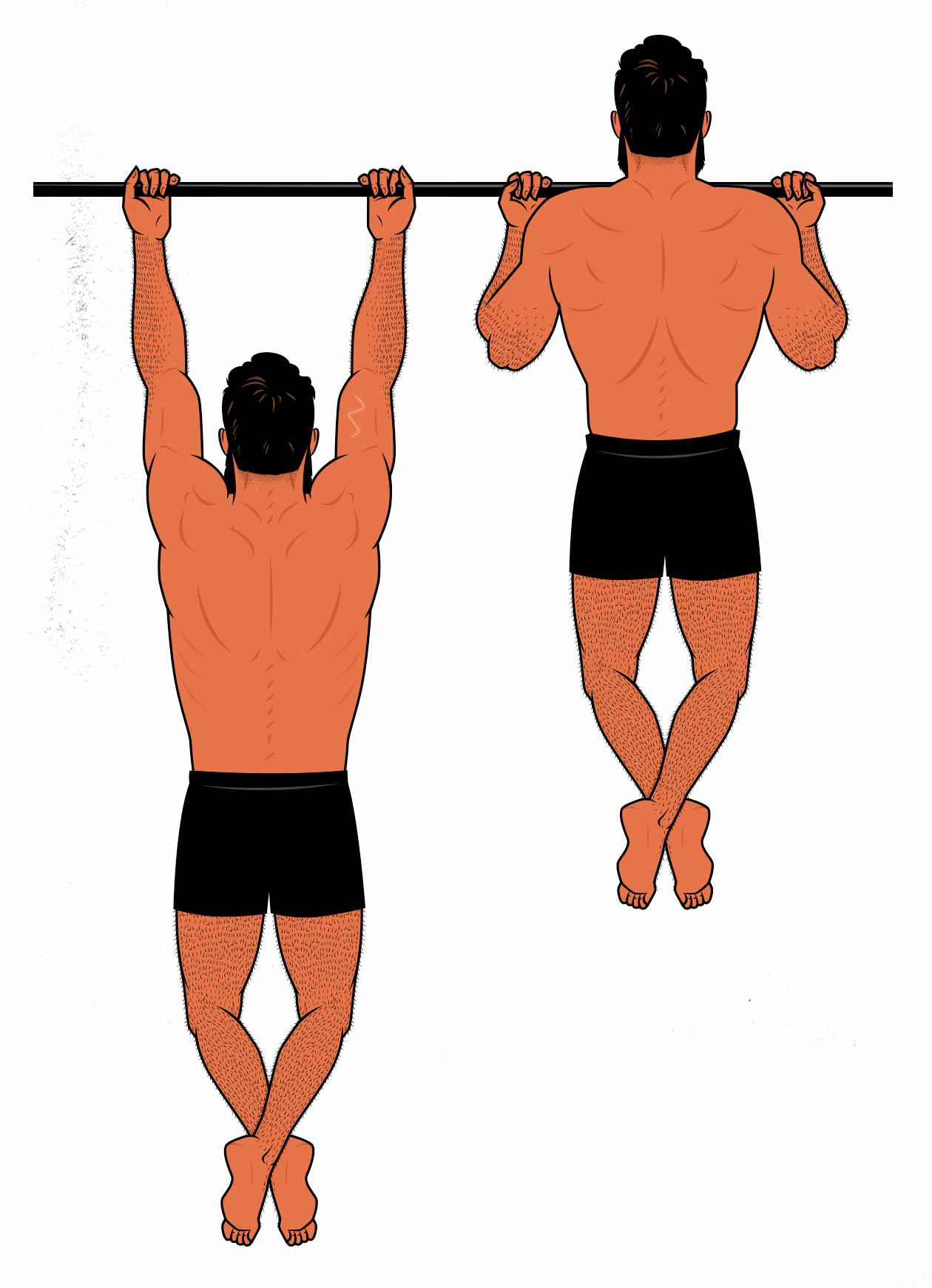
With lifts that don’t work our spinal erectors, such as the chin-up, pull-up, lat pulldown, and t-bar row, you can probably benefit from training them at least 3 times per week without much risk of it interfering with your other lifts.
With the lifts that hit your spinal erectors hard, such as barbell rows and deadlifts, you might want to be more conservative, doing them just once a week, especially if they leave your back feeling sore for several days. That way, you aren’t being limited by your back strength when doing squats, curls, and so on.
How Often Should You Train Your Legs?
The muscles in our legs are the biggest muscles in our bodies, and so they can often get quite sore for quite a long time. It’s common for people to only train their legs twice per week, especially if they’re strong and especially if those workouts are challenging.
Our quads and glutes are the two biggest muscles in our bodies, and like our chests, it’s possible to challenge them in a deep stretch, stimulating a ton of muscle growth and causing quite a lot of disruption. For example, in this study, it took 4 days to fully recover from doing 5 sets of 12 repetitions on the leg press. As a result, you may only want to train your legs 2–3 times per week, especially as you get stronger.
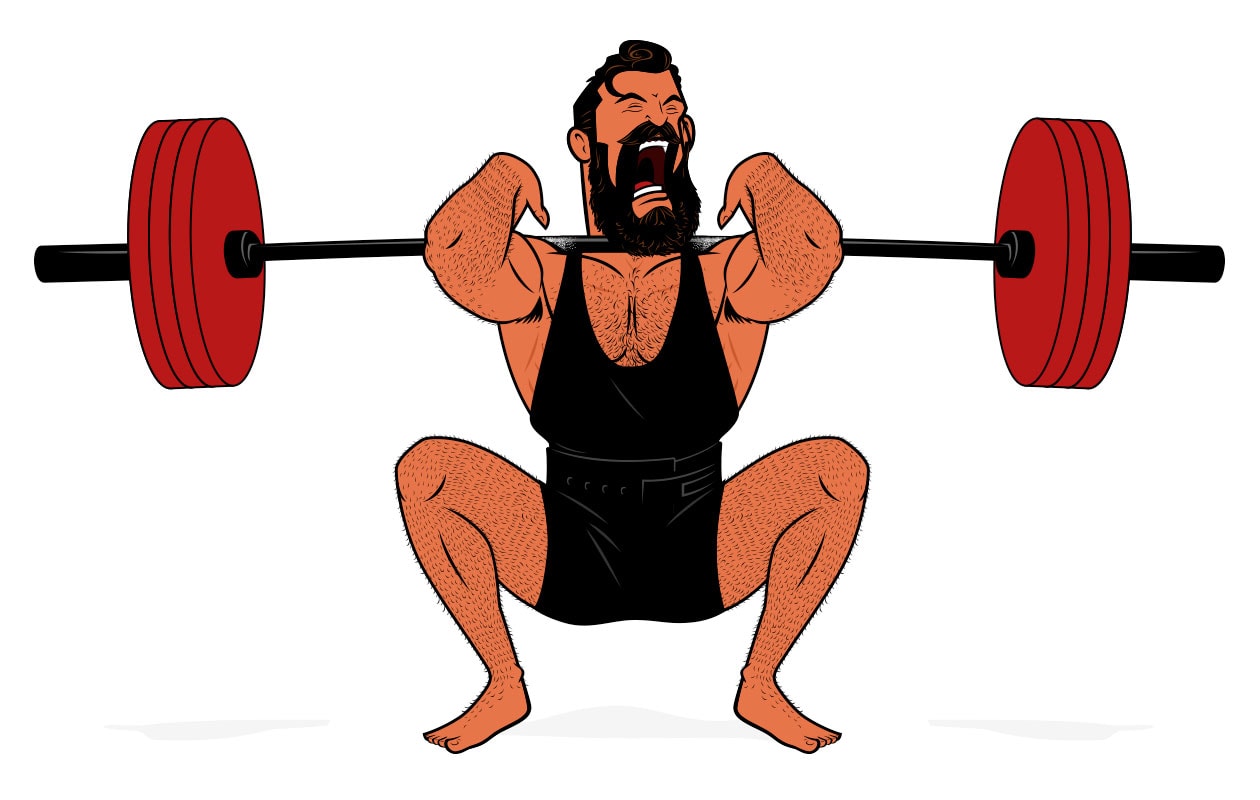
When we do a deep front squat, high-bar squat, leg press, or leg extension, we’re working our quads through a full range of motion, and it’s the bottom of that range of motion that tends to be the hardest, which is amazing for stimulating muscle growth. Then, because our quads are so massive, it can take quite a while for them to recover. Plus, the big leg exercises tend to be so heavy that they cause quite a lot of overall fatigue. If we’re training our legs more often, it can leave less energy for our other lifts. That’s why people often find it hard to bulk up their upper bodies when doing programs like StrongLifts 5×5 and, to a lesser extent, Starting Strength.
Now, to be clear, we’re talking about building muscle here. If you’re training for strength, there are a number of popular programs that recommend squatting every day, and that’s fine. But those workouts aren’t designed to stimulate muscle growth. When you’re working out to build muscle, it’s better to train your legs a bit harder but less frequently. Doing 4–9 sets for each leg muscle twice per week will probably be enough to maximize your rate of muscle growth.
How Often Should You Train Your Shoulders?
Our shoulders are a fairly big muscle group, but similar to our backs, most shoulder exercises have a fairly poor strength curve, so it’s hard to stimulate much growth or cause much muscle damage. Many people benefit from training their shoulders as often as 3–4 times per week.
For example, if we look at the most famous shoulder exercise, the overhead press, the strength curve is such that it’s hardest when the barbell is at forehead height, where your front delts are already at fairly short muscle lengths. It works them quite hard, and they’re certainly the limiting factor, but it’s nothing compared to how a bench press works the chest or how a squat works our quads. As a result, our shoulders can often recover fairly quickly. If we train our shoulders with the bench press, close-grip bench press, and incline bench press, we can challenge them at longer muscle lengths, but even then, they often recover quite fast.
Plus, your shoulders have different muscle heads that benefit from different shoulder exercises. Your front delts need pressing exercises, your side delts need lateral raises, and your rear delts need pulling exercises. As a result, many people train the different heads of their shoulders on different workout days.
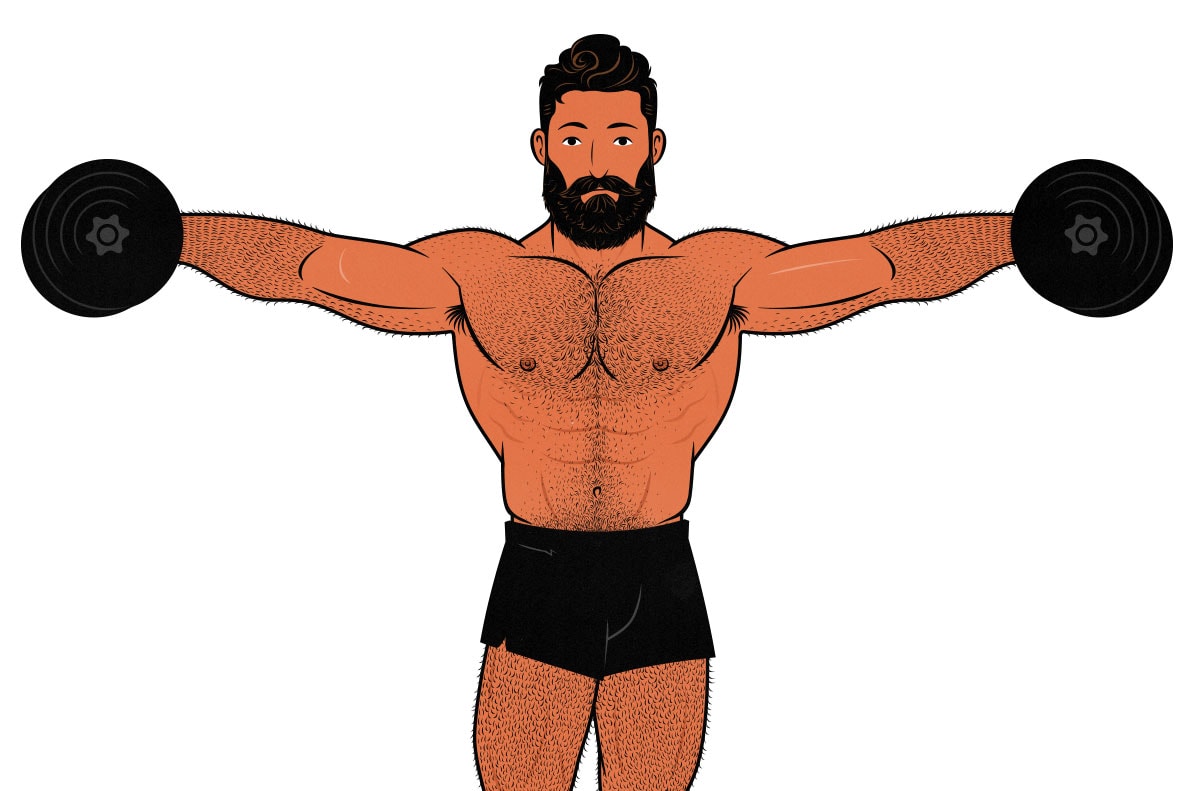
How Often Should You Train Your Arms?
If you train your arms hard, then training them twice per week is probably enough to maximize their rate of muscle growth. But if you’re only doing a couple of sets of biceps curls or triceps extensions at the ends of your workouts, it can help to train them more often.
The muscles in our arms are fairly small, and it’s common for people to train them 3–4 times per week. Mind you, that’s because most people don’t train their arms with the same rigour as they train the muscles in their torsos. If you choose good arm exercises and you do them early enough in your workout, it’s possible to stimulate at least a few days of muscle growth.
One study found that back muscles need 2 days to recover from doing 8 sets of rows, whereas your biceps recover in just 1 (study). The reason is that rows don’t work your biceps very hard. When the participants did 8 sets of preacher curls, it took their biceps over 4 days to recover.
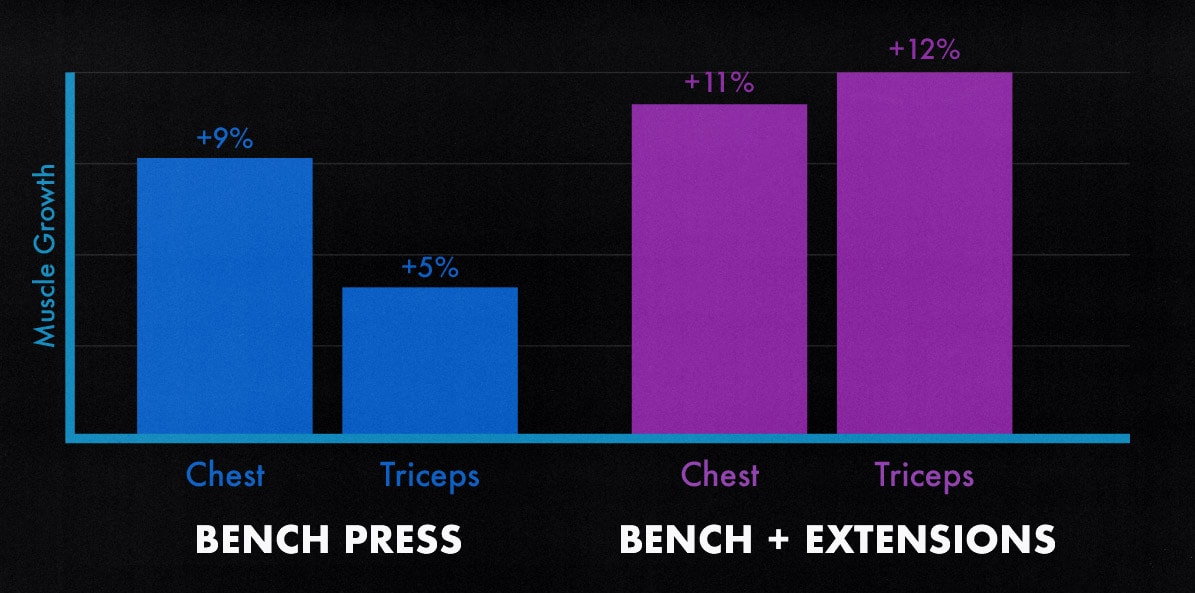
Then, if we look at the research on isolation lifts, it’s clear that we can grow our arms much faster by including direct arm work (study). So, after doing your compound lifts, you could add in some biceps curls, triceps extensions, lateral raises, and forearm curls. If you do that 2–3 times per week, you can keep your muscles growing all week long.
Another option is to train your arms with compound lifts during some workouts, then have a dedicated Arm Day where you focus purely on your arms.
How Often Should You Train Your Abs?
Our abs recover quite quickly and can handle quite a lot of training volume, meaning that we can train them a few times per week without any issues. And since our abs are active during most of our lifts, we often train them every workout—even if we never do any ab isolation exercises.
Like your arms, your abs will get a little bit of work during most of your workouts. The chin-up, push-up, overhead press, front squat, and a variety of other lifts all train your abs. As a result, it’s common for people to build big abs simply by doing big compound lifts. But if you notice your abs falling behind, doing some crunches or hanging leg raises at the end of your workouts can work wonders.
How Many Days Per Week Should You Work Out?
Okay, now that we’ve talked about how often you should train your muscles, let’s talk about how to organize that into different workout routines. For example, if you want to train your muscles 3 times per week, there’s more than one way to do that:
- 3-Day Full-Body Workout Routine, where you train your entire 3 times per week.
- 6-Day Upper/Lower Workout Split, where you train your upper 3 times per week and your lower body 3 times per week.
In both cases, you’re training your muscles 3 times per week, and so both workout routines can be similarly effective, depending on how you program them.
2-Day Full-Body Workout Routines
To build muscle at full speed, you need to train each muscle at least twice per week. That means you can build muscle quite well with just 2 full-body workouts per week. That seems to be enough to get virtually all of the health benefits of resistance training, too.
You can stimulate 3 days of muscle growth with a full-body workout (study). There’s also research showing that training our muscles twice per week causes just as much muscle growth as training them 3 times per week (study). You should be okay.
The problem with working out just twice per week is that it’s easy for the workouts to become long and draining. It’s hard to do squats, bench presses, deadlifts, overhead presses, and chin-ups all in the same workout. It’s even harder if you stack isolation exercises on top of that.
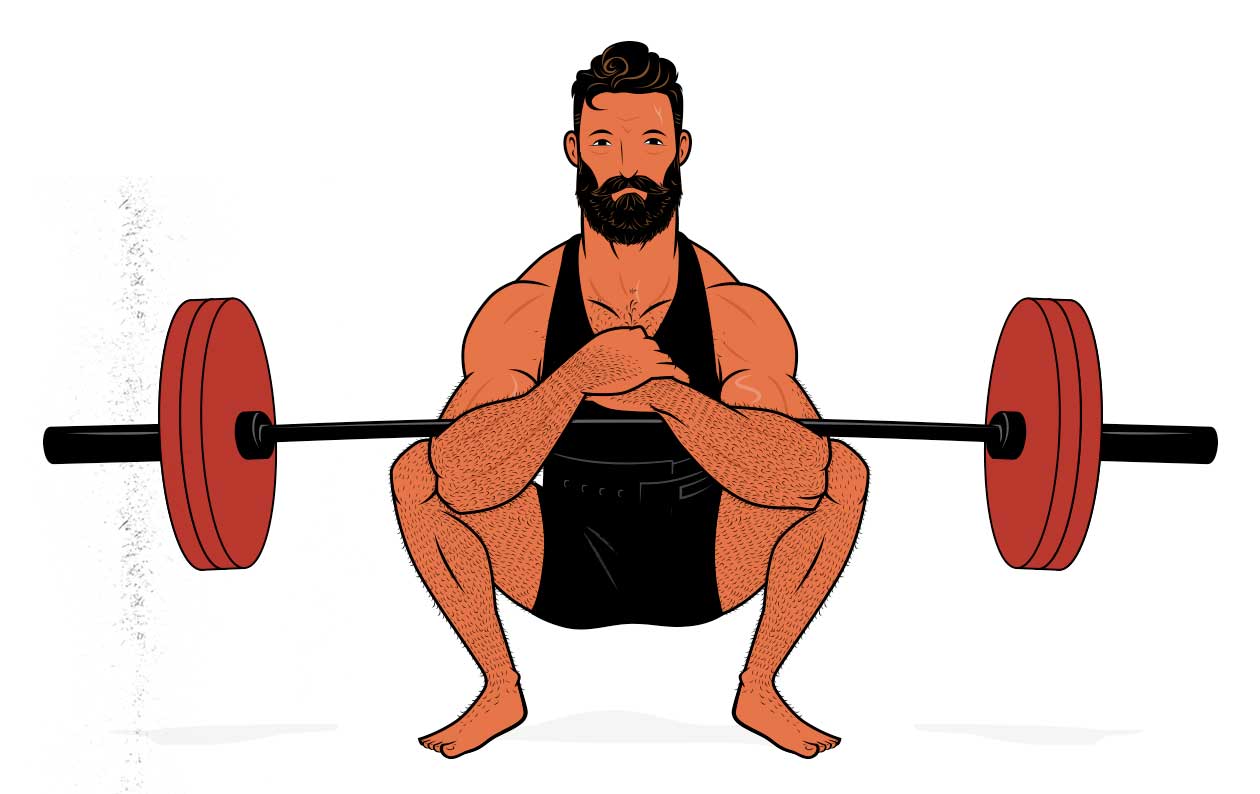
To build a 2-day workout program, we recommend making 2–3 different full-body workouts and alternating between them. For example, the first workout might have 3–4 sets of front squats, the second might have no squats, and the third might have 2–3 sets of Zercher squats. That gives you a squat frequency of 1.5 times per week and one of the squat workouts is fairly easy. That frees up time and energy for mixing in a wider variety of lifts, allowing you to make your program more balanced and allowing you to keep each workout from becoming overly fatiguing.
3-Day Full-Body Workout Routines
If we’re working out 3 days per week, that gives us a bit more wiggle room. We only need to train our muscles twice per week, so not every workout needs to train every muscle. That makes things much easier. For instance, we can squat and bench twice per week but train our shoulders and arms three times per week.
The research on full-body workout routines is quite good, too. For example, in this study, putting a rest day between the full-body workouts allowed the participants to fully regain their strength, allowing them to train hard again. This is important because it means that even just that single day of rest is long enough to allow us to outlift ourselves every workout, achieving progressive overload.
Why would you do 3 full-body workouts per week? If you’re a beginner, doing 3 full-body workouts per week will work all of your muscles often enough for you to build muscle as fast as possible, and having a day (or two) of rest between your workouts will give your body a chance to recover. Your hands will get a break, so will your traps, so will your back, and so will your connective tissues.
Even as an intermediate lifter, doing 3 full-body workouts is often enough to allow you to build muscle at full speed overall. But you might have some areas that you can’t invest a lot of energy into. That can mean doing specialization phases, where you spend a few months focusing on just a few muscle groups. That way, you can bulk up your arms, build a bigger bench press, or accomplish whatever it is you’re eager to accomplish.

Personally, I’ve gained 65 pounds by doing 3 full-body workouts per week. Then, when life is busy, I’ll train just twice a week. There are advantages to training more often, and we’ll cover those in a moment, but you can continue getting bigger and stronger with less.
What are the downsides? If you’re an intermediate lifter, you could make an argument that doing more workouts per week gives you more time to train a wider variety of muscles—your neck, forearms, calves, and so on—without needing to shift priority away from the big lifts. By adding more workouts, we give ourselves more time and energy to do more exercises.
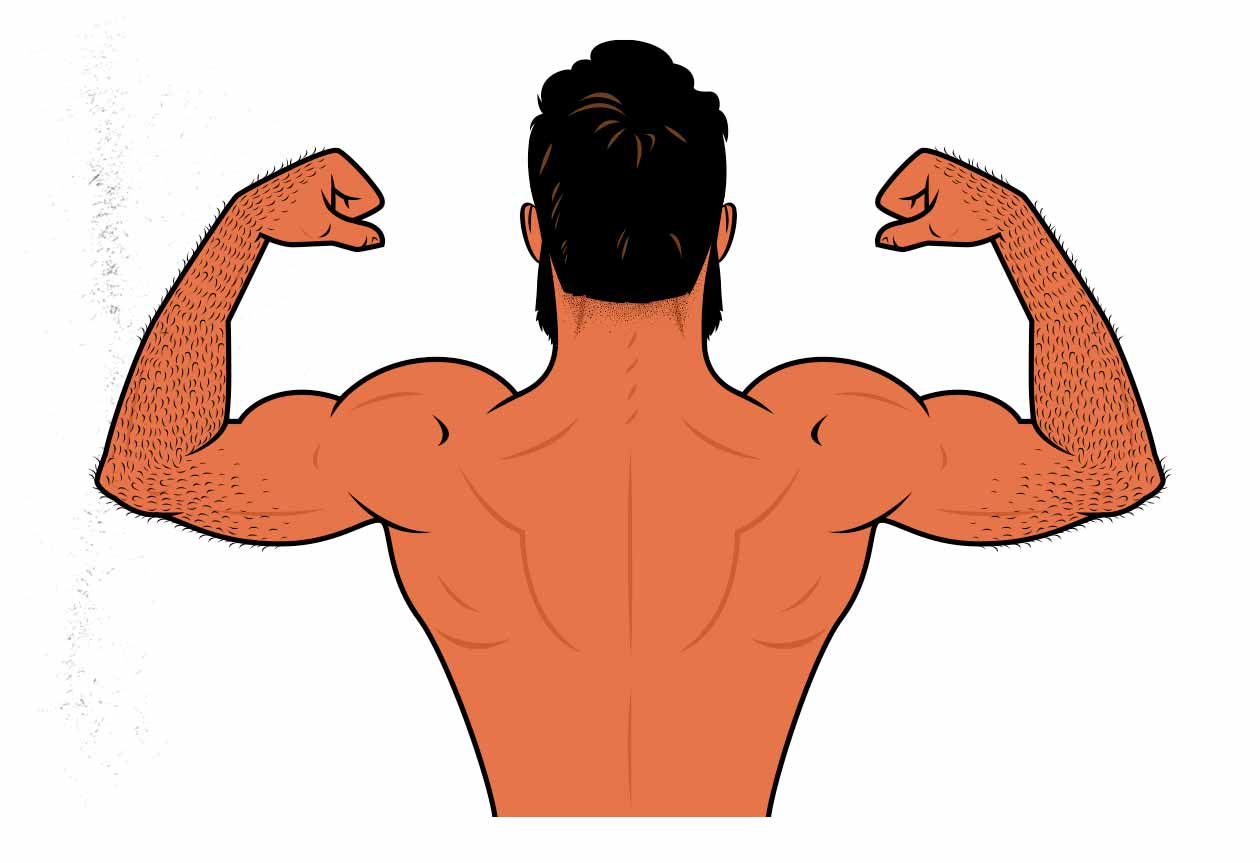
To build a 3-day workout program, make 2–3 different full-body workouts and alternate between them. For example, the first workout might have the bench press, the second might have the overhead press, and the third might have weighted dips. You’re training your chest 3 times per week with a nice variety of exercises. (This is the approach we used in the 3-day Outlift workout routine.)
4-Day Split Workout Routines
If you’re working out 4 days per week, that gives us a lot of great options. You only need to train your muscles twice per week, so now we can explore body-part splits, perhaps even using a combination of full-body workouts and body-part splits.
- 3 full-body workouts + an arm day: if you’re enjoying doing 3 full-body workouts per week but you want some extra arm work, these are great. You can do full-body workouts on Monday, Wednesday, and Friday, then blast your arms on Saturday.
- An upper/lower split routine: a common way for athletes to bulk up is to alternate between upper-body and lower-body workouts. Monday you start with the bench press and row; Tuesday you start with the squat and Romanian deadlift; Thursday you start with the chin-up and overhead press; and Friday you start with the deadlift and leg press. Marco loves these, and has had great success using them.
- 2 full-body workouts + an upper/lower split: my personal favourite way to train 4 days per week is to do a full-body workout on Monday and Wednesday, a lower-body workout on Friday, and then an upper-body workout on Saturday. It gives every muscle at least a day of rest, and it does a better job of spacing out the big compound lifts, keeping each workout fairly easy. (This is how we built the 4-day Outlift workout routine.)
However, it’s worth noting that when compared to full-body workouts, 4-day workout routines don’t necessarily stimulate more muscle growth overall. For example, in this study, the participants doing a 4-day routine gained the same amount of muscle mass as the group doing 3 full-body workouts per week.
Why would you do 4 workouts per week? As you get stronger, your sets become more draining, requiring longer rest times. On the bigger lifts, it’s common for 2-minute rest periods to become 3 minutes, then 4 minutes, and then 5. As the workout drags on, it’s hard to grind through exercise after exercise. That’s when you could switch to specialization phases or add a fourth workout day.
What are the downsides? There are no major downsides to training 4 days per week other than the extra time investment, especially if you need to commute to a gym. Our connective tissues still get plenty of rest, and most people can recover from them fairly well.
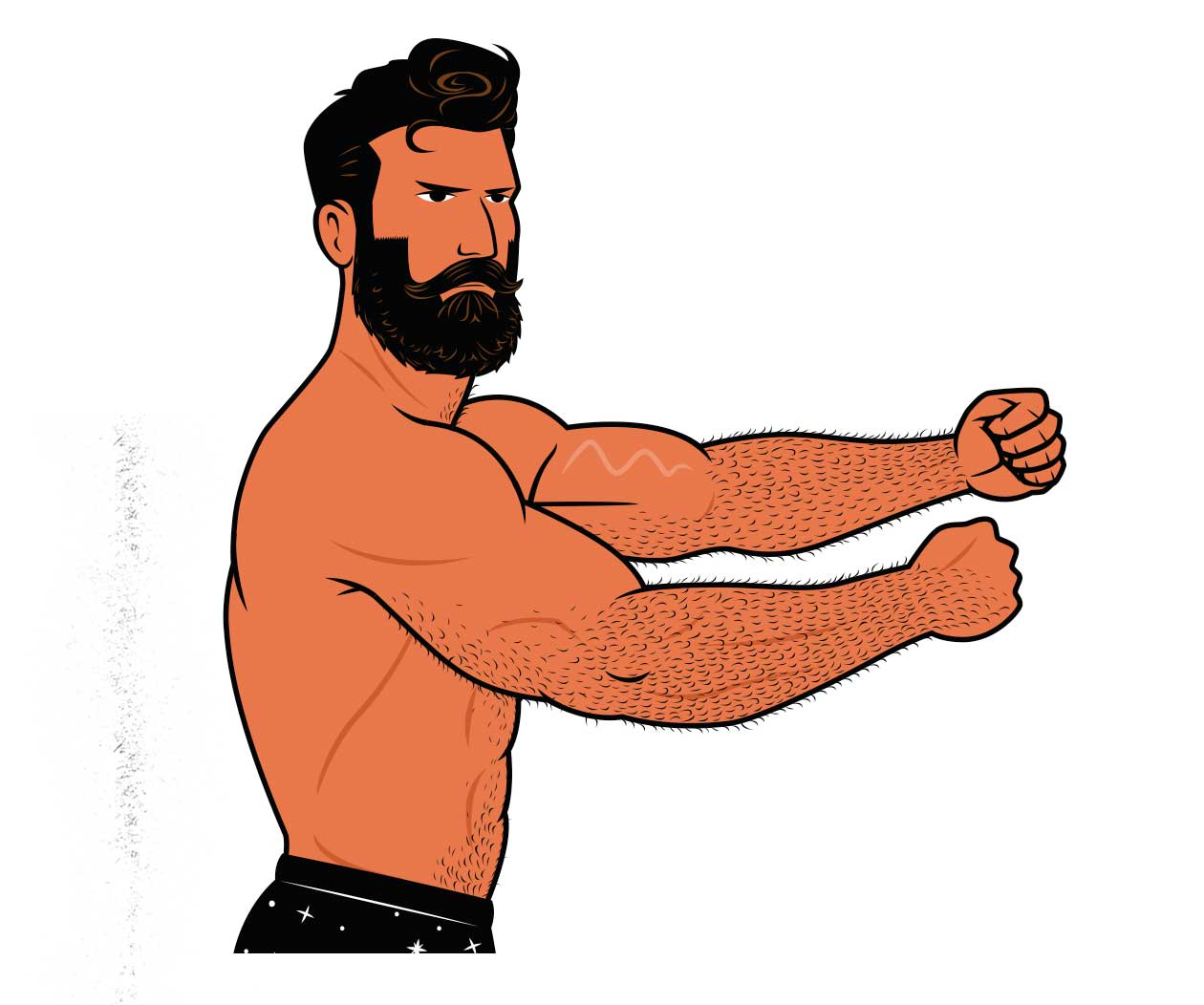
5-Day Workout Routines
If you’re working out 5 days per week, you’ll probably be doing a 5-Day Bro Split. We have a variation of that called the 5-Day Outlift Split. Both of those routines can work quite well, but they aren’t necessarily better than training 3–4 days per week.
- Monday: Chest Day
- Tuesday: Back Day
- Wednesday: Shoulder Day
- Thursday: Leg Day
- Friday: Arm Day
- Saturday: Rest
- Sunday: Rest
Why would you do 5 workouts per week? As you get stronger, your workouts get heavier and harder. By working out more days per week, you can spread the exercises out over more days, keeping your workouts short. Those shorter workouts are easier to manage, especially if you enjoy going to the gym or enjoy training at home. It becomes part of your daily routine.
You also have the option of doing longer workouts, filling them with obscure isolation exercises, bulking up every neglected muscle all at once. You can train all the big muscles and still have room left for your calves, forearms, neck, gluteus minimus, and rectus femoris.
What are the downsides? When you’re lifting weights 5 days per week, that means doing a lot of back-to-back workouts. Even if you use an elaborate body-part split that keeps you from training your muscles two days in a row, you still need to watch out for fatigue, especially in the areas being worked every day, such as your grip and spinal erectors.
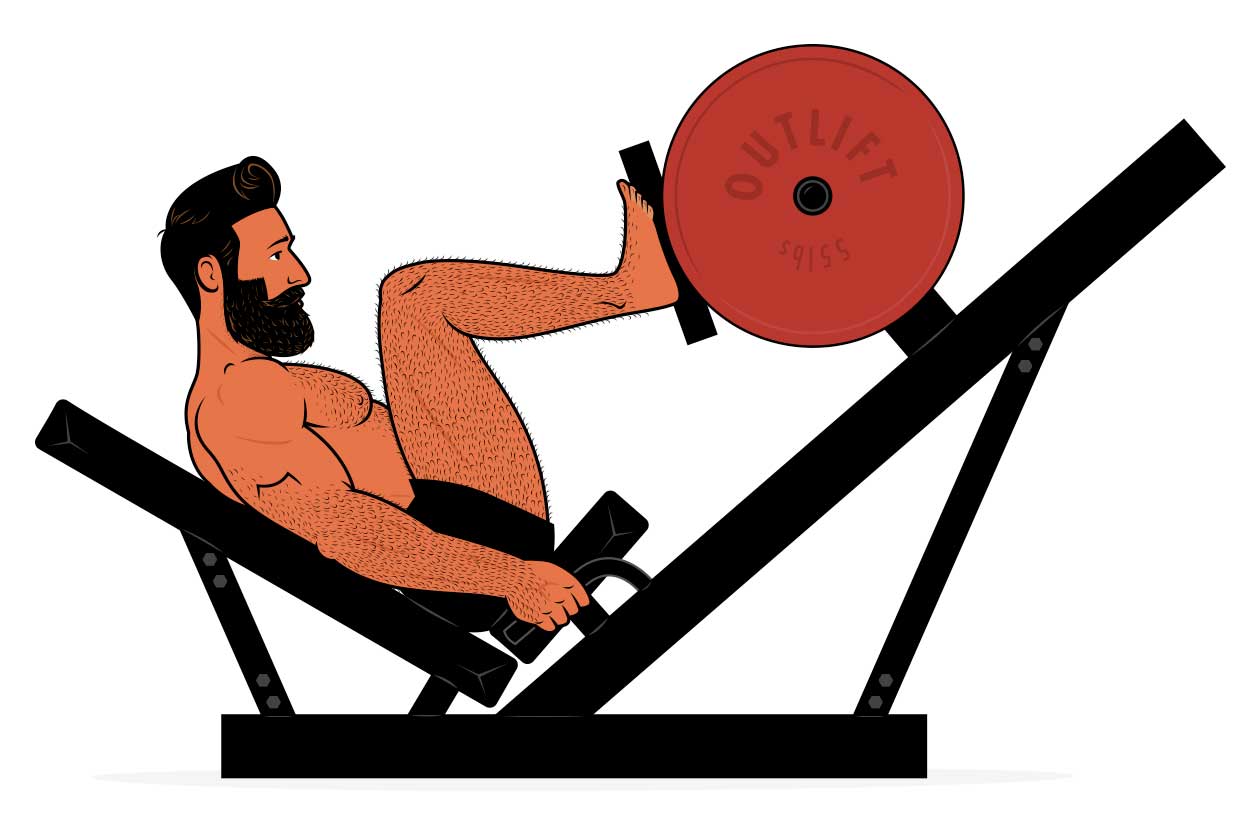
6-Day Split Workout Routines
The most popular 6-day workout program is the 6-day Push/Pull/Legs Workout Split. It’s an intense but effective workout routine that trains every muscle at least twice per week.
- Monday: Push Day
- Tuesday: Pull Day
- Wednesday: Leg Day
- Thursday: Push Day
- Friday: Pull Day
- Saturday: Leg Day
- Sunday: Rest
Why would you do 6 workouts per week? Some people don’t like doing long, gruelling workouts, and so they enjoy spreading the workload out over as many days as possible, and that’s great. Other people enjoy going to the gym or find it easy to dip into short home workouts. If you want to lift weights more often, this is a good way to do it.
What are the downsides? When you’re lifting 6 days per week, that means lifting 6 days in a row, and without ever taking getting 2 days of rest in a row. That’s a lot, and so it becomes important to manage fatigue. The workouts tend to be short, and you may need to intentionally use smaller lifts to avoid fatiguing your stabilizer muscles: seated shoulder pressing instead of standing, exercise machines instead of free weights, t-bar rows instead of barbell rows, and so on. That’s not a problem, but it can make your training less efficient.
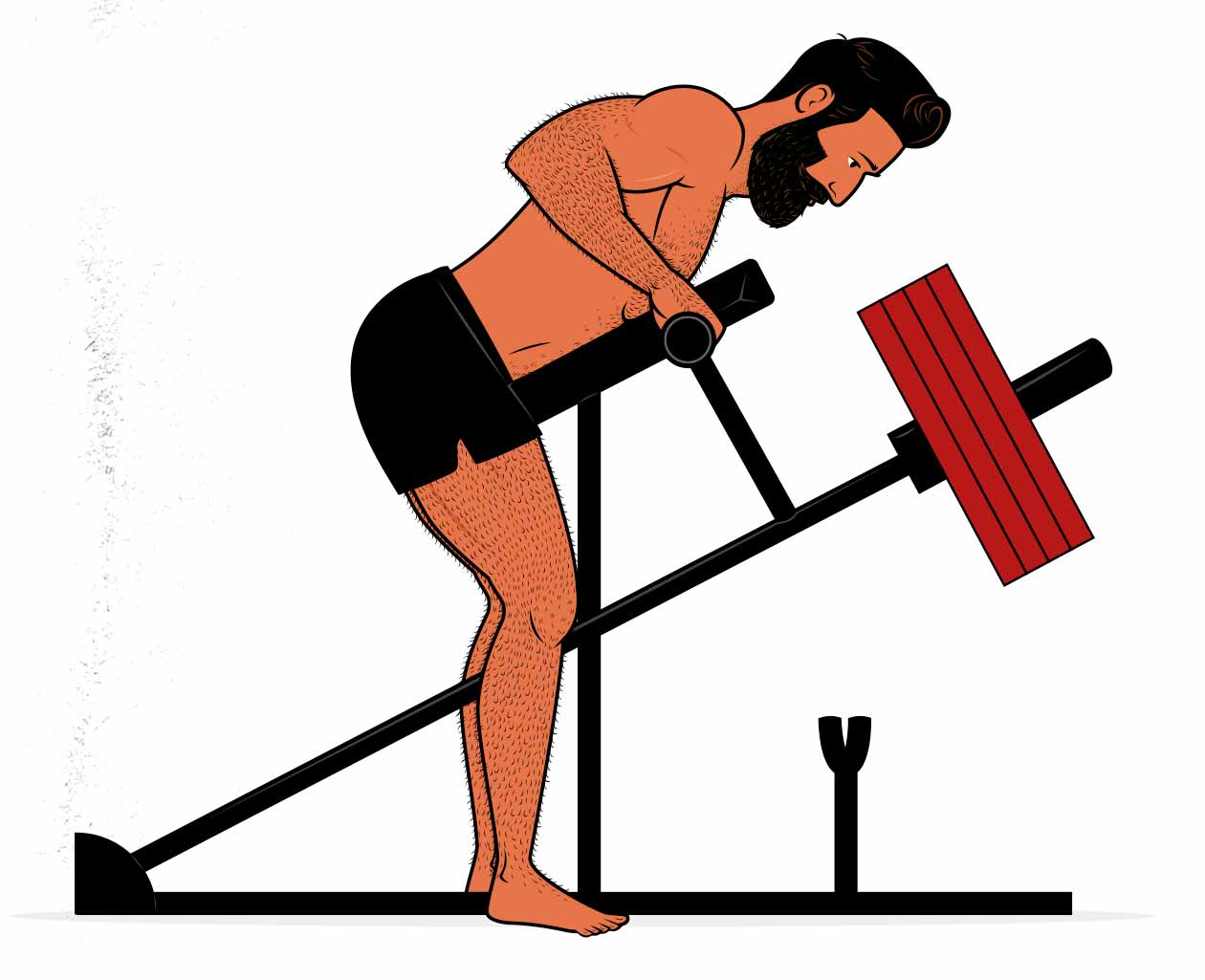
Doing Both Cardio & Weight Training
I won’t go too deep into this here, given that we have a full article on combining weight training with cardio, but if you’re lifting weights more than 3 days per week, it’s something to consider. If the reason you’re working out more often is to improve your health, it may be best to combine different types of exercise to get a wider variety of benefits.
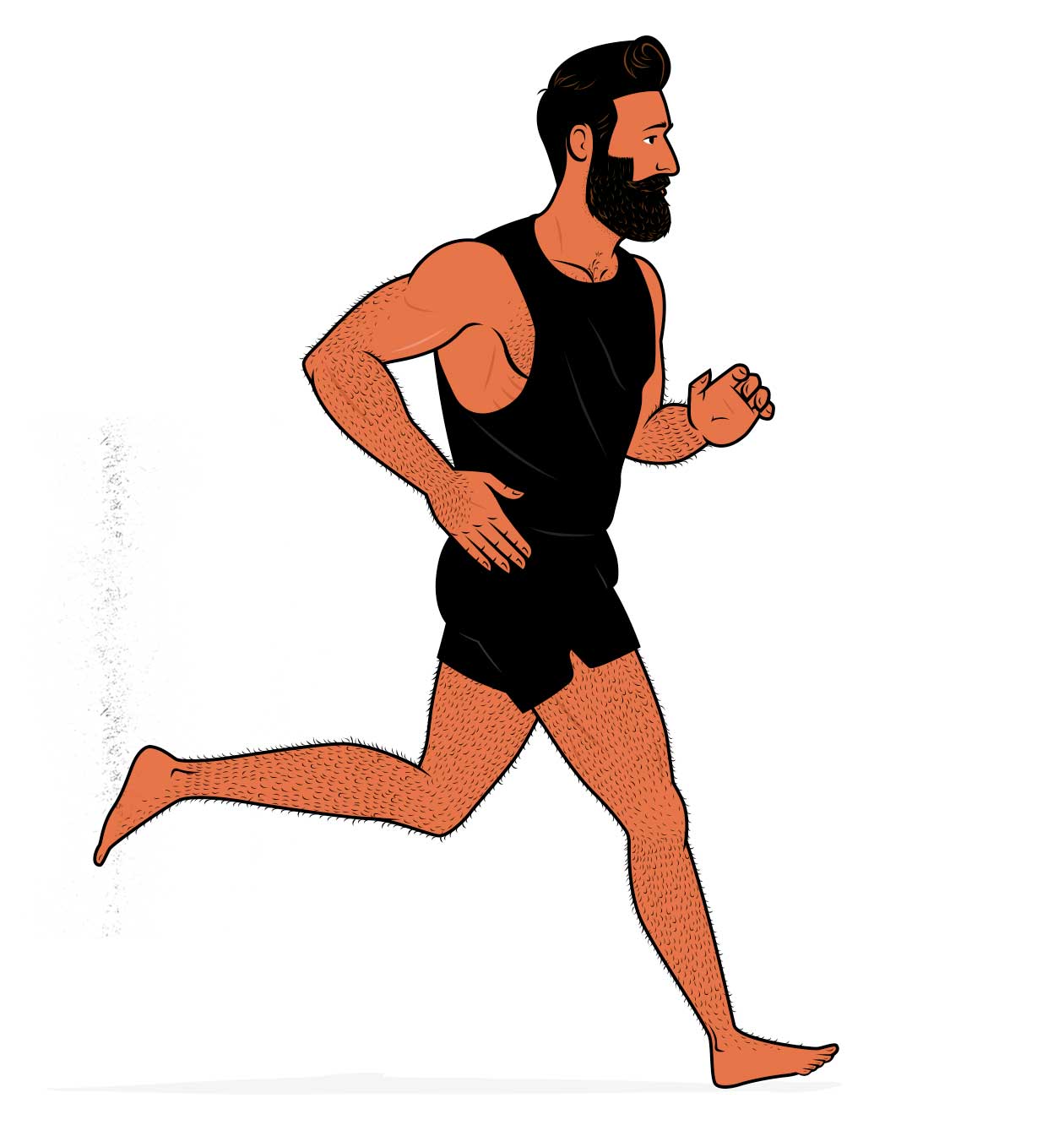
For a quick example, if you wanted to train 5 days per week, there’s always the option to do something like this:
- Monday: full-body workout
- Tuesday: a long, brisk walk outside
- Wednesday: full-body workout
- Thursday: stationary biking for 30–60 minutes
- Friday: full-body workout
Summary
Training your muscles 2–4 times per week is ideal for building muscle. Working out more often than that is good, but it won’t always speed up muscle growth, and you’ll need to watch out for fatigue.
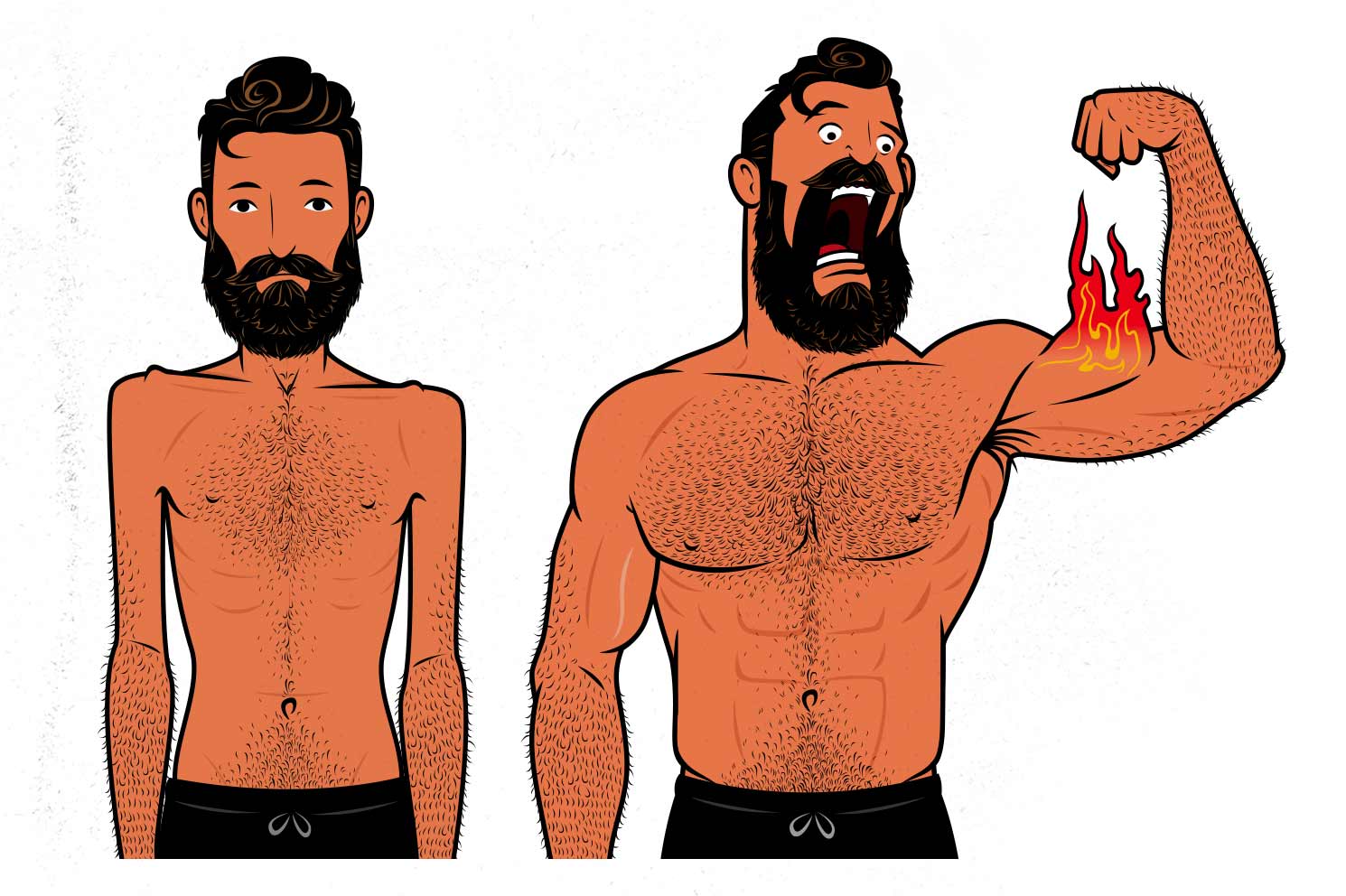
Many different workout routines can keep your muscles growing all week long, ranging from 2-day full-body routines all the way to 6-day workout splits. As a default, we recommend 3-day full-body routines for beginners and early intermediate lifters. Then, once those workouts start getting too long and hard, or if you start running up against a plateau, consider adding a fourth or even fifth day.

If you want a customizable workout program (and full guide) that builds in these principles, check out our Outlift Intermediate Bulking Program, which includes both 3-day and 4-day workout routines. We also have our Bony to Beastly (men’s) program and Bony to Bombshell (women’s) program for skinny and skinny-fat beginners. Both use 3-day full-body workout routines.




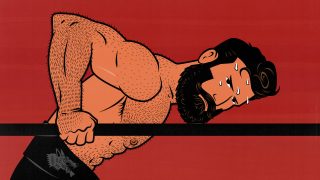
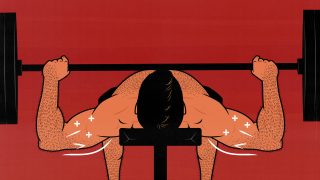

Thanks for this! Happy to see you touch on this topic.
I’ve been doing 6-day upper/lower splits for about a year now and I like it. It’s mostly about schedule and psychology for me. I work out at home and 6 short workouts are easier to fit in than 3 long ones. I’m less likely to skip a workout when it’s a near-daily routine. Plus, I CAN do my workout at 9pm after kids are in bed if something prevents it during the day. It’s not fun but it’s doable, while a 1+ hour workout is really hard that time of night.
To your comment about managing fatigue, I found that splitting the 4-day Hard Outlift routine in to 6 days was too much for me, especially in that 5th week. I now run the 4-day Easy rearranged in to 6 days and it’s great. MWF is mostly (but not completely) lower, while THS is upper body. Average workout length across the 6 days and 5 weeks is about 35 minutes. Still leaves room for a little cardio a couple times per week.
Thank you, Kevin!
Yeah, I think once you go beyond 3 days as a beginner, 4 days as an intermediate, it’s less about stimulating more muscle growth, more about picking what you prefer. And in that case, I hear ya. I find long workouts a grind, too, especially with a young kid. I still only train 2–4 days per week, but I use specialization phases so that I can still fight for progress in some areas. Your approach is probably better, mind you 😛
I have just discovered this website and the content is incredible!
Right now I workout every other day, alternating between push and pull days. For example: push (bench, overhead press, squat, shoulder and triceps acessories), off, pull (chinup, deadlift, curls, row), off, push, off, pull etc.
Comes out to working each body part only twice every eight days.
Is there a better way to program? I am thinking of moving the rows to the push day and overhead press to the pull day, to even things out a bit.
I would love to hear your thoughts.
Thanks!
Thank you so much, Spencer!
Working each body part twice every 8 days is perfect. Would it be even better if you were training your muscles twice every 7 days instead? I don’t know. I doubt it would make a meaningful difference. If this is working for you, I don’t see any issue with it. Sounds great 🙂
But, yeah, you could spread the lifts out a bit. You could do a superset of bench press + rows on one day, then a superset of chin-ups + overhead press the other day. That way you’ve got some pushing and pulling on each day, but each day still has an emphasis. We do that sometimes in our programs. It works quite well.
I’ve pretty much done the same routine for the last 8 months, as a 52 year old with 30 years of training under my belt, I find it the perfect routine to hit each muscle with enough frequency to maintain, just add intensity if you also want to grow, the main difference with my routine is that I do Bi’s on Push day and Tri’s on Pull day, this routine gives my old joints ample rest.
Hi Shane, very important topic you have addressed. Mostly the internet is full of articles that discuss frequency of training same muscle. Frequency of total workouts is not addressed so much.
Anyway, as you have mentioned that muscle building continues 2-3 days after which it cab be trained again. But what if soreness persists for, say, 5 days if you have hit the muscle very hard? like in once per week frequency where entire volume of all exercises is executed in same day? Is being sore or feeling symptoms of under-recovery a sign that muscle building is still underway even if it is more than 3 days?
I think it would have been great if you had discussed the frequency of training a muscle in perspective of intensity of the workout. For example frequency of working lats at or above 90% of max capacity compared to training lats at 75% – 80% of max capacity. I believe both these intensities shall dictate different frequency bcoz of magnitude of muscle damage and neural fatigue of nervous system.
Hey Farhan, that’s a good question. It’s definitely possible to train a muscle so hard that it takes many days to recover. Sometimes a full 5+ days, yeah. That usually means doing a ton of hard sets, though, and there doesn’t seem to be much benefit to doing that. If we look at the research on push/pull/legs routines, we see that splitting the volume up over 2–3 workouts builds more muscle.
It seems that beyond a certain point, extra sets don’t really stimulate any extra muscle growth, just extra muscle damage. It seems like doing more than 5–12 sets per workout, depending on the person, doesn’t really add much extra value. For most people, especially if you’re using good lifts, that range of 3–8 challenging sets is good.
There are exceptions, but as a general rule of thumb, yeah, better to spread the volume out over 2+ workouts.
As for intensity, this article is about building muscle, so we’re not really interesting in sets with fewer than 5–6 reps per set or more than 30–40 reps per set. Those intensities aren’t very good for stimulating muscle growth. We’ve got a full article on rep range/intensity, though: https://outlift.com/hypertrophy-rep-range/
That’s not to hate on heavier sets. I do heavier sets. I just finished benching 315 for a single. But I’m not doing that to build muscle, I just want to be able to say that I can bench 3 plates, you know? To build a bigger chest, I’m doing 8–15 reps with 225–265.
With strength training, though, you generally want to favour recovery. Strength training is all about showing up fresh and lifting more weight. So give yourself some extra time. Wait until the soreness abates, then give it an extra day or two.
Yes Shane, agreed, after a certain point the extra sets just push us deeper in recovery hole and give no extra gains. That sweat spot may differ person to person. I too, like frequency of more than once per week. Sure.
Exactly 🙂
I feel like people don’t ever say this.
Shane, everything you’re creating here is remarkably beautiful. I really appreciate the attention to detail in design. Thank you. Calms my heart.
The main illustration here is fucking hilarious. Typography is kept simple. The color pallete everywhere is consistent and nice: Website, Forum, PDFs, *everything* (Did you paint your home gym wall main-book-cover-blue oder make the book gym-wall-blue?). I didn’t check, but I’m sure even the damn CSS is structured nicely.
<3
Thank you so much, Fabian! That means a lot 😀
Ahaha yeah, I painted my home gym a similar blue to the b2B blue. Sort of a Caribbean Ocean Blue, I guess you’d call it. It’s a colour I really like, and I thought it would match the vibrancy we try to have with our sites. So, yeah, it was intentional 😛
Hi Shane,
Many thanks for all your excellent work on this site – after just a couple of visits it became my first port of call.
This article reflects most of what I’ve read (albeit in a more comprehensive and well-structured way). However, I’ve seen several examples of people going well above the recommended volumes and seeing great results. I remember reading about one intermediate-advanced lifter, for example, who had trained his biceps and triceps directly 4-5 times (a total of 12-15 sets each) per week directly, on top of all his upper body compound pulling and pushing movements, for an 8-month period, and had seen huge gains there.
This suggested to me that biceps and triceps can recover enough to be trained on consecutive days, so long as it’s around three sets per session and you don’t go quite to failure. It also suggested that exercises like the bench press, overhead press, pull ups and rows don’t cause much damage to biceps and triceps, since otherwise with this frequency the arm muscles surely wouldn’t recover.
For the past couple of weeks I’ve therefore been on a two-day cycle (as far as the upper body goes). On day 1, I’ve been doing 3 sets each for the biceps, brachialis and triceps. On day 2, I’ve been doing (among others) chest press, overhead press, pull ups and rows. My reasoning was that upper arm growth would be stimulated every day, but upper arm recovery from the exercises on day 2 wouldn’t take more than a day, and, in the event that it took my upper arm muscles more than a day to recover after working them directly on day 1, the (limited?) stress placed on them on day 2 wouldn’t significantly impair their recovery after they’d had a full day already.
Would you agree, or does what you’ve read indicate otherwise? The more conventional method would, of course, be to train the upper arms with the rest of the upper body, and then give them a full day off. I’m just curious as to whether you think stimulating growth every day in this fashion would still tend to impair recovery in most people.
Many thanks,
Marcus
Hey Marcus, thank you!
Yeah, most people overestimate how hard the compound lifts work their arms. You might do a few sets of the bench press and feel nothing in your triceps, get no pump, feel no soreness there, and not see much growth. That’s especially true with wide-grip barbell bench presses and dumbbell bench presses. In a situation like that, you almost don’t want to count the bench press as a triceps exercise. Better to only count the lifts that challenge your triceps. And the same is true with the biceps. Chin-ups can be good, but rows and pull-ups don’t work them very hard, and the best results tend to come from biceps curls.
I think your idea sounds good. You might get similar results by including your arm work with your regular workouts. For instance, you might get a killer triceps workout by doing a bench press followed by skullcrushers, and it’s pretty convenient because you can do both exercises on the same bench. As an advantage, your elbows will be warmed up from the bench and your triceps will already be slightly fatigued, meaning you might get more stimulation with less joint stress. Or maybe you find you get a way better triceps workout if you start your workout fresh. I’d try and compare the two approaches.
If you give yourself 2 days of per week, and take a deload week every month or two, you shouldn’t need to worry too much about recovery. Your arm muscles are fairly small, and any lingering fatigue can be cleared with the rest days and deload. Just watch your elbows. If they start aching, you might want to ease back on the curls and extensions, dropping them a lower frequency again.
Many thanks Shane. What you say about training muscles when they’re already fatigued to avoid joint stress is interesting and I hadn’t thought of that before. I assumed training muscles when fatigued would result in less mechanical stress since the weight would be lower – however, you’ve written about a study where tricep extensions AFTER a bench press resulted in better growth than in the reverse order. Maybe because the mechanical stress they experience during the bench is greater, since triceps aren’t the limiting factor and the weight can therefore be raised? Or is it simply that putting a muscle through X weight induces different levels of mechanical stress depending on how fatigued it is?
I might try cable pushdowns after benching to finish off the short and lateral heads, and then hit the long head with overhead extensions on the following day? Perhaps if I alternate between emphasising the different heads on consecutive days (3 or 4 in a row) I’ll get the benefits of stimulating growth daily, but allow the muscle to recover? Or maybe this is likely to still impair recovery too much…I’d very much appreciate any insight you might have here.
Many thanks again,
Marcus
You’re totally right. More mechanical tension on the muscles means more muscle growth. The idea is to start putting the stress on our triceps in a way that’s less likely to aggravate the elbows, such as with a close-grip bench press, and then switch to a movement that’s better for the triceps at the cost of being harder on the elbows, like a skullcrusher or overhead triceps extension. Your logic is good, though. Starting with a skullcrusher might yield more triceps growth specifically in the long head, which isn’t worked properly with the bench press. And if your elbows feel fine when doing it, I don’t see a problem there.
But, yeah, so far, based on the research that we have, I’m leaning towards benching then extensions as the best default.
I think cable pushdowns are a good all-around triceps exercise. Maybe a bit less stretch on the longer heads, sure, but the movement at the shoulder joint is good. If anything, your shoulders are extending as you push the weight down. Same dynamics as the skullcrusher and overhead extension. All of them are great movements for the triceps, and I’d imagine all heads are being worked quite well.
Your plan of doing bench + pushdowns one day and then overhead extensions the next is worth trying. I think it makes sense. You’re getting some good variety there. Again, just make sure that your elbows are feeling okay 🙂
Many thanks for all your replies yesterday Shane – I appreciate all the advice and have adjusted my routine accordingly. Looking forward to reading your next articles (please keep them coming!).
Hey Shane, great article as usual! I didn’t know you were living in Mexico, I hope we are treating you and your family well.
One question on frequency: given that I’m not really lifting weights during the quarantine and only working out with calisthenics (and loving it by the way), I was wondering if this allows for a faster recovery, therefore higher frequency during the week would be fine.
Once I go back to the gym, I’m still planning to keep a couple of days with calisthenics only, and a couple more with traditional weight lifting.
Hey Victor, thank you. And yeah! My wife is from Cancun, I’m from Canada, so we split our time between the countries. Recently, we’ve been here in Mexico, and it’s been great. It’s a beautiful country with amazing people. We’re loving it here 🙂
I think it depends on how rigorous your bodyweight workouts are. Some calisthenics workouts might allow for quicker recovery, others not so much. If you’re lifting in higher rep ranges (20–40 reps per set) and taking your sets to failure, it’s pretty easy on the joints, but it can actually cause quite a lot of muscle damage, and so you might want a good couple of days between workouts.
You’ll often see people doing push-ups and chin-ups (and other calisthenics movements) every day, though, and it can work well. Those lifts require fairly little warming up, and they’re done from the comfort of your home, making it convenient to do shorter workouts more often. Plus, because high-rep training to failure is so damn painful, it can help to spread it out 😛
Shane,
How do you think you’ll split the time between Cancun and Canada when you have school-age children (if don’t already)? Ignore if too off topic and or too personal.
F
We’re not sure. I did notice that the same internationally standardized (IB) school that I went to in Canada is also available here in Cancun, and it’s within walking distance of our home. But even so, at a certain point, I think moving around could be disruptive to our kids’ friendships, even if the schooling isn’t a problem. Maybe that means staying in one country for a decade or two, just taking vacations to the other. We both love both countries, and we can be happy living in either one together. We’ll play it by ear 🙂
Hi Shane,
Just wanted to say how much I enjoy your articles. I get a real buzz when I see an email from the B2B team in my inbox
Really useful article, especially as someone who enjoys playing sports and is always balancing this with lifting.
Thanks,
Nick
Thank you so much, Nick!
Yeah, totally. Having different training frequency options becomes all the more important when balancing both lifting and sports. If you can pull it off, though, it’s a pretty ideal way to live 🙂
I love the look of this 5-day routine:
Monday: bench press + chest-supported rows and accessories.
Tuesday: front squat + Romanian deadlifts and accessories.
Wednesday: overhead press + push-ups and accessories
Thursday: chin-up + dips and accessories
Friday: deadlifts and margaritas.
You called it a body part split routine, but depending on the accessory exercises, it could easily be considered a 5-day full body program, where each body part is hit at least twice per week. I might sub the margaritas for a squat assistance movement, though!
Ahaha yes, a squat assistance exercise could definitely work there 🙂
New to the site (love it), and a question for you:
I see a lot of your focus is for skinny guys— that’s not really me. I’m 6’3”, 208 lbs, and 17-18% body fat, last I measured.
I recently built myself a 5 day program, however have decided I wanted to reduce it to 3 days to allow more time for me to play basketball (love to do it and add some more cardio).
What are your recommendations if my primary goal is to reduce body fat (at or below 15%)? As for weight, if I were to drop closer to 200, I’d prefer that, but I also don’t mind where I’m at too much. Does this mean I should maintain a higher caloric deficit? I’ve recently converted to a flexitarian diet plan, which I enjoy. I know that this article addresses hypertrophy training, and maybe that doesn’t mesh well with losing a bit of weight/fat right now? But I know weight training is better for burning fat. Curious for your input. Thanks for the great content!
Hey Kevin, welcome! Thank you 😀
Yeah, you’re right. Hypertrophy training pairs great with fat loss. It will help you burn fat instead of muscle. And it’s sweet that you’re playing basketball, too. That’s a great form of exercise.
And you’re right about how to lose fat, too. You’ve got to get into a calorie deficit. Combine that with a higher protein intake (around 200 grams of protein per day for you), hypertrophy training, basketball, and good sleep, and you do great 🙂
Vey good article with great no nonsense information
Thank you so much, Will 🙂
Shane what a great article. I have questions if I may?
I have been NATURALLY training 25 years. I am now 40yo and thought I knew all there was to know. But everyday is a school day right, and reading this is a school day.
I split my training over 4 splits over 10 days. So Monday split 1… Wednesday split 2…Friday split 3 and Monday split 4………Wednesday -start again.
I will do Chest Tri split 1, Back biceps split 2, shoulders traps split 3 and legs 4.
But… a typical chest day for example will see me do 4 sets bench press, 4 sets incline press, 4 sets decline press, 4 sets flys…….then 5 different exercises on tris with 4 sets each. And I go full out. I train hard and to utter failure.
Repeat this with all splits. Around 30-40 sets per workout going for around 8-12 reps going hard.
I then follow this by 45min of cardio on the cross trainer.
I ache for days and days after each session. After a couple of weeks I am exhausted. I am trying to lose fat at the moment so I am only consuming around 1300 calories and I’m 6ft3 and 262lbs. I can still comfortably bench 250lbs for 8 reps….. but I am tired all the time!
So my question to you after reading your article is am I over-training? Am I wasting my time doing so many sets to failure? Using the science you quote, are all these sets just a waste?
You’re killing it, man! Congrats on 40 years of natural lifting! That’s awesome!
I’m not sure if you’re overtraining in the sense that you’re harming yourself. But, yes, you’re wasting time, effort, and energy by doing so many sets of similar exercises. Try doing 4 sets of a main compound lift (such as the bench press), 3 sets of a complementary compound lift (such as a dumbbell overhead press), and then doing 3 sets of isolation lifts for the muscles that haven’t been properly worked yet. In this case, that’s 3 sets of triceps extensions for your triceps (because compound pressing isn’t great for the long heads of your triceps) and 3 sets of lateral raises for your side delts (because pressing isn’t great for your side delts).
Give each set great effort. Really try to power that weight up. Every week, fight to improve, even if you can’t. Your workouts should be much shorter and should leave you with much more energy afterwards.
When you finish cutting, feel free to add some extra sets or exercises back in. You don’t need to, but you might find you have more energy when you’re eating more calories.
Keep at it, man! You’re doing great.
Monday or Tuesday:
Bench Press 3 sets 6-10 reps
Overhead Press 3 sets 6-10 reps
Deadlift 3 sets 6-10 reps
Weighted Chin Ups 3 sets 6-10 reps
Weighted Tricep Dips 3 sets 6-10 reps
Wednesday or Thursday:
Bench Press 3 sets 6-10 reps
Lateral Raise 3 sets 6-10 reps
Squat 3 sets 6-10 reps
Bicep Curl 3 sets 10-20 reps
Tricep Extension 3 sets 10-20 reps
Friday or Saturday:
Overhead Press 3 sets 6-10 reps
Squat 3 sets 6-10 reps
Deadlift 3 sets 6-10 reps
Weighted Chin Ups 3 sets 6-10 reps
Weighted Tricep Dips 3 sets 6-10 reps
What do you think? I’m trying to restructure my workout because I was spending 2-3 hours after work in the gym and not getting enough sleep. I’m experimenting to see if this will reduce my time in the gym to 90 minutes max but hit all my muscles at least twice a week. I’ve been lifting for 2 years after a long hiatus and due to the pandemic. Switched from 4 day split to 3 day full body but I was doing deadlifts, squats, overhead press, bench press, T-bar rows, pull ups and dips 3 times a week and since I going to a gym, waiting for the racks and bench can take a long time. Actually Fridays I would do leg presses to substitute for squat and deadlifts since the gym closes on Fridays. I would be in the gym from 7pm to 10pm Mondays and Wednesdays/9pm Fridays Will this new workout routine work, hit all the muscles, and save some time for me to sleep?
I can’t workout any other time of the day.
Hey Amit, that looks pretty good!
If you want to cut down on the length of your workouts, I’d consider supersets. We have an article on supersets here. For example, you’d do a set of squats, rest for a minute, then a set of chin-ups, rest for a minute, and then go back to squats. If you can’t hog multiple pieces of equipment at once, you can swap out bench presses for push-ups, back squats for goblet squats, barbell overhead presses for dumbbell overhead presses, and so on.
In your first workout, you’re already training parts of your triceps with the bench press and overhead press. Triceps dips train the same parts of your triceps. Better to choose triceps extensions. That way, you train your triceps in a more balanced way. Dips can be great for your chest, though. Triceps extensions tend to be a bit easier than dips. It might shorten your workout a bit.
Maybe in your second workout, you swap the bench press for weighted dips and finish with some overhead triceps extensions. That will make the workout a bit shorter, too.
In the third workout, you could swap the deadlifts for Romanian deadlifts. That way you do a better job of working your hamstrings. It will probably make your workout a bit shorter, too. Romanian deadlifts usually require a bit less rest between sets.
Your workout already looks good, though. I’m just trying to give you ideas 🙂
Good luck, man!
Hi Shane,
Let me ask you about this schedule that I made recently:
Monday (at gym)
Deadlift 3 sets of 8-12
Bench Press 3 sets of 8-12
Squat 3 sets of 8-12
Weighted Chin Up 3 sets of 8-12
Cable Tricep Extension 3 sets of 10-20
Rear Delt Fly (machine) 4 sets of 10-20
Tuesday (at home)
Dumbbell Bicep Curl 3 sets of 10-20
Dumbbell Tricep Extension 3 sets of 10-20
Dumbbell Lateral Raise 4 sets of 10-20
Wednesday (at gym)
Overhead Press 3 sets of 8-12
Weighted Tricep Dips 3 sets of 8-12
Bicep Curl 3 sets of 10-20
Dumbbell Fly 3 sets of 8-12
Dumbbell Lateral Raise 4 sets of 10-20
Rear Delt Fly 4 sets of 10-20
Thursday (at home)
Dumbbell Bicep Curl 3 sets of 10-20
Dumbbell Tricep Extension 3 sets of 10-20
Dumbbell Lateral Raise 4 sets of 10-20
Dumbbell Press 3 sets of 8-12
Dumbbell squats 3 sets of 8-12
Friday (at gym)
Deadlift/Romanian Deadlift 3 sets of 8-12
Bench Press 3 sets of 8-12
Squat/Leg Press 3 sets of 8-12
Weighted Chin Up 3 sets of 8-12
Cable Tricep Extension 3 sets of 10-20
Rear Delt Fly (machine) 4 sets of 10-20
Monday to Friday I walk on average 7000-8000 steps per day because I live in New York City. The reality of commuting to and from work here.
Saturday/Sunday
Cardio: Treadmill walk/run or bike 30-60 minutes
Thursday and Friday workouts I may switch depending on my schedule. I came up with this schedule a few weeks ago because I’ve read that each muscle group should be worked out a minimum of 12 sets per week. I think this schedule achieves that volume.
Do you think I’m hitting every muscle groups with the appropriate volume or am I doing too much? Do I have too little time to recover? Am I going to spend too much time in the gym?
Can I have a life to go out on a date or spend time with friends with this schedule?
Also with Romanian Deadlifts what percentage of the conventional deadlift should I be putting on or should it be equal to to conventional deadlift?
I still have some belly fat and struggling to get rid of it. I track my macros and do my best cut out sugar, bad fat etc. I try eat carbs around my workouts. Last time I check I had almost 20% body fat.
Thanks for your help!
Amit
Hey Amit,
Your active lifestyle sounds great 🙂
That’s a pretty intense workout routine, especially for your arms. It’s way more volume than I ever do. That isn’t necessarily a bad thing, though. Some people respond well to higher training volumes. If you’re one of those people, this might work really well for you, especially for your arms.
I wouldn’t just jump right into a routine like this, but if it’s about the same volume as your previous workout routine, or if your previous routine was slightly lower in volume, and you think you can benefit from more, then this could be a good next step to try.
You can probably survive and have friends and fall in love and do other things.
Eating a healthy diet is great for your health and recovery. The easiest way to lose fat is with a calorie deficit, but that’s a whole other thing. We have an article on cutting here.
I hope that helps, and good luck!
Hello Admit,
I’m confuse on biceps/ triceps arm isolation exercises.. I train with 4 Day Lower/ Upper Split. I hit all 6 movements H. Push/ Pull, V. Push/ Pull, Sq and Dl.
For my Upper Push/ Pull exercises I have a strength day and hypertrophy. I try to stick with mostly compound movements 12 sets per week.
Upper Strength:
Hori. Push: BB Bench Press 3*6
Hori. Pull: BB Bentover Rows 3*6
Incline: BB Incline Press 3*6
Vert. Pull: Chin ups 3*6
Upper Hypertrophy:
Hori. Push: BB Bench Press 3*10
Hori. Pull: Single Arm Cable Pulls 3*10
Incline: BB Incline Press 3*10
Vert Pull: Single Arm Lat Pull Downs 3*10
With my upper routines is it really necessary for me to add isolation for biceps/ triceps? I’m still in the early stage of a novice working on getting my strength up.
Thank you,
Peter
Hey Peter, that’s a good question.
It isn’t necessary to add isolation exercises.
Isolation lifts will speed up the growth of your arms. You’ll get more balanced muscle growth in your arms, too, because you’ll do a better job of stimulating the various muscle heads. But none of that is necessary. You’ll gain some size in your arms with or without them. You can be strong and healthy with or without them. Isolation lifts will just help you gain more size, more quickly, in a more balanced way.
There are different ways of focusing on getting your strength up. If you want bigger arms, it will pay to focus on gaining strength on arm exercises like bicep curls and tricep extensions. If you want broader shoulders, you could try to get your strength up on lateral raises. Very similar to how if you want a bigger chest, it pays to focus on getting stronger at the bench press. What you focus on is entirely up to you 🙂
Keep it up, man!